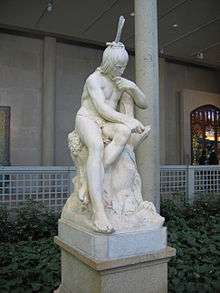Henry Hilton
Judge Henry Hilton (October 4, 1824 – August 24, 1899) was an American jurist and businessman. He became best known for the so-called "Hilton-Seligman Affair" in 1877, his refusal to admit financier Joseph Seligman to the Grand Union Hotel in Saratoga Springs, New York, reportedly because Seligman was Jewish, but also possibly because of a personal feud.[1]
Biography
Hilton was born in Newburgh, New York on October 4, 1824,[2] the youngest son of a Scottish immigrant.[1] He moved as a boy to New York City and was educated there. He became a law clerk with the firm of Campbell & Cleveland in 1839. He was admitted to practice at the Court of Common Pleas in 1846, and later served as a Master in Chancery.[2]
Campbell & Cleveland represented A.T. Stewart, "The Merchant Prince," and Hilton became Stewart's private counsel in 1850. In the 1850s Hilton married Ellen Banker, a cousin of Mrs. Stewart and the sister of James H. Banker, President of the Bank of New York. He was a judge of the Court of Common Pleas from 1858 to 1863, and also served as Parks Commissioner for a time.[2] In 1862 he is listed on the rolls of the Tammany Society.[3]
Mr. Stewart died in 1876, and Hilton served as his executor, receiving a bequest of one million dollars for his services, which Mrs. Stewart paid by transferring the business of A.T. Stewart to him. In 1886 Mrs. Stewart died and Hilton again served as executor. Judge Hilton retired from A.T. Stewart in 1883. There are two different accounts of his success in business. According to his biography[2] "he was entirely successful, and when he retired in 1883 ... his sons and son-in-law succeeded to the business and soon dissipated the property." According to the New York Times, however, Hilton presided over "the dissipation of one of the greatest fortunes ever amassed by trade."[1]

In 1879 Hilton bought an estate named "Woodlawn" in Saratoga Springs from Henry Walton. The estate, which Hilton renamed "Woodlawn Park", comprised 1,500 acres (610 ha) of woods and meadows.[4] Hilton improved the property, laying out 25 miles (40 km) of graveled carriage roads, a great mansion, stables, barns, gardens, lakes, a club house, a ballroom, and an athletic field.

Augustus Saint-Gaudens Hiawatha stood in front of the house. The grounds were open to members of the public with permission from Judge Hilton.[5]:pp.212–213 Hilton died at Woodlawn on August 24, 1899, "after a long illness."[1] Following Hilton's death the property was left to decay, and was auctioned off as eight parcels in 1916. A portion of Woodlawn is now the campus of Skidmore College.[4] Hilton is interred at Green-Wood Cemetery in Brooklyn, New York.
References
- "Henry Hilton is Dead" (PDF). New York Times. August 25, 1899. Retrieved March 31, 2013.
- Johnson (ed.), Rossiter; Brown (ed.), John Howard (1906). Biographical Dictionary of America (vol.v). Boston: American Biographical Society.CS1 maint: extra text: authors list (link)
- Blake, Euphemia (1901). History of the Tammany Society; Or, Columbian Order from Its Organization to the Present Time. Souvenir Publishing Company.
- Skidmore College. "Woodlawn Park" (PDF). Archived from the original (PDF) on May 29, 2010. Retrieved March 31, 2013.
- Waller, George (1966). Saratoga: Saga of an Impious Era. New York: Bonanza Books.